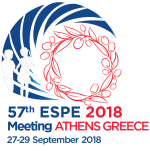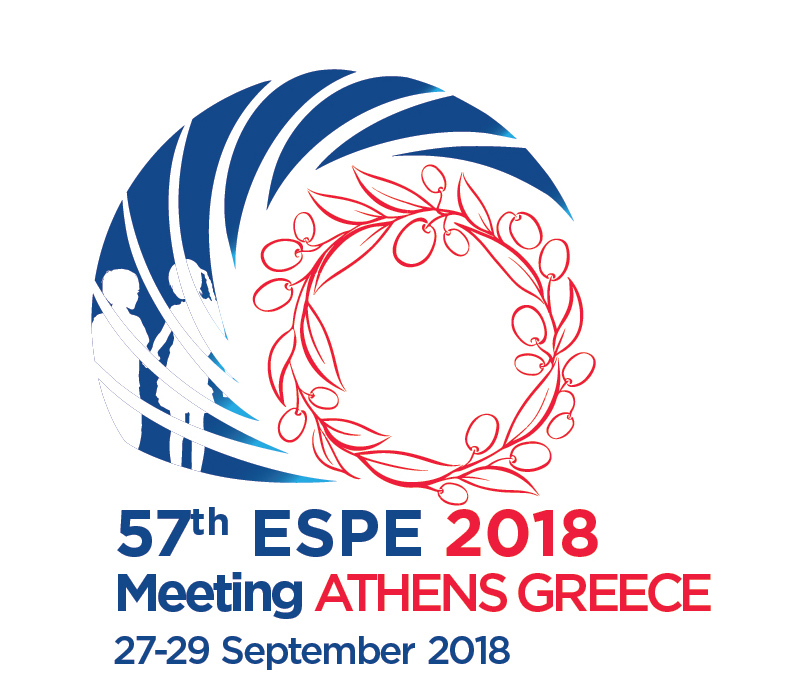
57th Annual ESPE
Athens,
Greece
27 Sep 2018 - 29 Sep 2018

Poster Presentations
Pituitary, Neuroendocrinology and Puberty P2
hrp0089p2-p301 | Pituitary, Neuroendocrinology and Puberty P2 | ESPE2018
Efficacy and Safety of Triptorelin 3-Month Formulationin Patients with Central Precocious Puberty and BMI Evaluation.
Galli Francesca , Cavarzere Paolo , Ben Sarah Dal , Antoniazzi Franco , Gaudino Rossella
hrp0089p2-p302 | Pituitary, Neuroendocrinology and Puberty P2 | ESPE2018
Triptorelin Test in Idagnosing Central Precocious Puberty
Vukovic Rade , Milenkovic Tatjana , Mitrovic Katarina , Todorovic Sladjana , Plavsic Ljiljana , Soldatovic Ivan
hrp0089p2-p303 | Pituitary, Neuroendocrinology and Puberty P2 | ESPE2018
Foot Length Growth is a Novel Marker of Early Puberty
Balzer Ben , Lun Cheng Hoi , Garden Frances , Luscombe Georgina , Paxton Karen , Hawke Catherine , Handelsman David , Steinbeck Katharine
hrp0089p2-p304 | Pituitary, Neuroendocrinology and Puberty P2 | ESPE2018
Ultrasound-Based Measurements of Testicular Volume in 6–16 Year Old Boys: Intra- and Inter-Observer Agreement and Comparison with Prader Orchidometry
Oehme Ninnie , Roelants Mathieu , Bruserud Ingvild Saervold , Egil Eide Geir , Bjerknes Robert , Rosendahl Karen , Juliusson Petur B
hrp0089p2-p306 | Pituitary, Neuroendocrinology and Puberty P2 | ESPE2018
Longitudinal Follow-up to Near Final Height of Auxological Changes in Girls with Idiopathic Central Precocious Puberty Treated with Gonadotropin-Releasing Hormone Analog and Grouped by Pretreatment BMI level
Park Jongho , Kim Yong-Dae , Han Heon-Seok
hrp0089p2-p307 | Pituitary, Neuroendocrinology and Puberty P2 | ESPE2018
The Effect of GnRH-Analogue Therapy on the Quality of Life of Patients with Central Precocious Puberty and Their Families
Lucaccioni Laura , Pugliese Marisa , Manzotti Elena , Bruzzi Patrizia , Righi Beatrice , Poluzzi Silvia , Madeo Simona F , Bigi Elena , Predieri Barbara , Iughetti Lorenzo
hrp0089p2-p308 | Pituitary, Neuroendocrinology and Puberty P2 | ESPE2018
A Novel Inactivating Compound Heterozygous Mutation in KISS1R/GPR54: Cases of Three Siblings
Nalbantoglu Ozlem , Arslan Gulcin , Koprulu Ozge , Hazan Fılız , Gursoy Semra , Ozkan Behzat
hrp0089p2-p309 | Pituitary, Neuroendocrinology and Puberty P2 | ESPE2018
MKRN3 Gene Mutations in a Cohort of Patients with Central Precocious Puberty
Stefanija Magdalena Avbelj , Kovač Jernej , Yablonski Galia , Toromanović Alma , Stipančič Gordana , Milenković Tatjana , Jančevska Aleksandra , Zdravković Vera , Jesić Maja , Vuković Rade , Stanković Sandra , Todorović Sladana , Hovnik Tinka , Phillip Moshe , Battelino Tadej , de Vries Liat
hrp0089p2-p310 | Pituitary, Neuroendocrinology and Puberty P2 | ESPE2018
Can Basal Levels of Luteinizing Hormone (LH) Replace the GnRH Test in the Diagnosis of Precocious Puberty in Girls?
Llano Juan , Morales William , Pineda Catherine , Ortiz Teresa , Gil Nayibe , Laverde Gladys , Castro Sonia , Llano Mauricio
hrp0089p2-p311 | Pituitary, Neuroendocrinology and Puberty P2 | ESPE2018
Incidence of Delayed Puberty in Adolescents. A Population-Based Study in a County in Central Sweden
Rodanaki Maria , Rask Eva , Lodefalk Maria
hrp0089p2-p312 | Pituitary, Neuroendocrinology and Puberty P2 | ESPE2018
Ultrasound Assessment of Pubertal Breast Development: Intra- and Inter-Observer Agreement
Bruserud Ingvild , Mathieu Roelants , Oehme Ninnie , Egil Eide Geir , Bjerknes Robert , Rosendahl Karen , Juiliusson Petur
hrp0089p2-p313 | Pituitary, Neuroendocrinology and Puberty P2 | ESPE2018
Neuroendocrine Consequences of Hypothalamic Hamartoma and their Imaging (MRI) and Surgery Correlates
Corredor Beatriz , Caredda Elisabetta , Ederies Ash , Tisdall Martin , Cross Helen , Spoudeas Helen A.
hrp0089p2-p314 | Pituitary, Neuroendocrinology and Puberty P2 | ESPE2018
The Start Predictors of Puberty in Boys with Constitutional Delay of Puberty
Brzhezinskaia Liubov , Samsonova Lyubov , Latyshev Oleg , Okminyan Goar , Kiseleva Elena , Kasatkina Elvira
hrp0089p2-p315 | Pituitary, Neuroendocrinology and Puberty P2 | ESPE2018
Research on the Relationship between Secular Trends of Pubertal Development and Obesity in Child and Adolescent
Xiong Feng , Luo Xuan , Song Cui , Zhu Gao-Hui , Zhu Min
hrp0089p2-p316 | Pituitary, Neuroendocrinology and Puberty P2 | ESPE2018
Gonadotropin Levels and Frequency of Testosterone Supplementation in Adolescents with Klinefelter Syndrome
Tseretopoulou Xanthippi , Mushtaq Talat
hrp0089p2-p317 | Pituitary, Neuroendocrinology and Puberty P2 | ESPE2018
The Effect of Letrozole on the Reproductive Function and Linear Growth in the Early and Mid Puberty Boys
Ma Huamei , Lin Juan , Zhang Jun , Li Yanhong , Chen Qiuli , Du Minlian
hrp0089p2-p318 | Pituitary, Neuroendocrinology and Puberty P2 | ESPE2018
SOX3 Gene Duplication Associated with Midline CNS Malformations, Hypopituitarism and Neurodevelopmental Abnormalities: 5 Unrelated Cases
Chawla Garima , Nambisan Aparna K.R. , Arya Ved B. , Muhi-Iddin Nadia , Vamvakiti Katia , Ajzensztejn Michal , Hulse Tony , Buchanan Charles R. , Kapoor Ritika R.
hrp0089p2-p319 | Pituitary, Neuroendocrinology and Puberty P2 | ESPE2018
An 18 Month Old Boy with Hypoglycemic Convulsion and Obesity Due to POMC Deficiency
Betul Kaygusuz Sare , Yesil Gozde , Kırkgoz Tarık , Turan Serap , Bereket Abdullah , Guran Tulay
hrp0089p2-p320 | Pituitary, Neuroendocrinology and Puberty P2 | ESPE2018
Pituitary Stalk Interruption Syndrome (PSIS) is Not a Rare Cause of the Congenital Hypopituitarism
Eren Erdal , Yazici Zeynep , Demirbas Ozgecan , Gulleroglu Nadide Basak , Tarım Omer
hrp0089p2-p321 | Pituitary, Neuroendocrinology and Puberty P2 | ESPE2018
Pallister Hall Syndrome: An Unusual Case of Central Precocious Puberty, Prolonged Vaginal Bleeding, Gelastic Seizures and Polysyndactyly in a 3 Month Old Infant
Arciniegas Larry , Iglesias Beatriz , Campos Ariadna , Lopez Fermina , Montanez Angel Sanchez , Clemente Maria
hrp0089p2-p322 | Pituitary, Neuroendocrinology and Puberty P2 | ESPE2018
Primary Empty Sella Syndrome and Clnical Endocrine Polymorphisms in Children: a Report of 15 Cases
Kayemba-Kay Simon , Ribrault Alice , Hindmarsh Peter
hrp0089p2-p323 | Pituitary, Neuroendocrinology and Puberty P2 | ESPE2018
Growth Hormone Deficiency (GHD) in a Patient with Persistence of the Craniopharyngeal Canal with Cephalocele
Caiulo Silvana , Pitea Marco , Partenope Cristina , Gallo Dario , Damia Chiara , Adavastro Marta , Fioretti Lorenzo , Barera Graziano , Weber Giovanna , Pozzobon Gabriella
hrp0089p2-p324 | Pituitary, Neuroendocrinology and Puberty P2 | ESPE2018
Endocrine-Metabolic Characterization of Pediatric Patients with Craniopharyngioma: A Single-centre Cohort study
Pedicelli Stefania , Sette Giulia , Cianfarani Stefano , Cappa Marco
hrp0089p2-p325 | Pituitary, Neuroendocrinology and Puberty P2 | ESPE2018
Growth Hormone (GH) Secreting Pituitary Adenomas in Paediatric Practice: 5 Cases Over 20 Years in a Single Tertiary NeuroEndocrine Centre
Brooker Elspeth , Munshid Sarrah El , Arya Ved , Kalitsi Jennifer , Ismail Dunia , Kapoor Ritika , Bullock Peter , Thomas Nick , Mandeville Henry , Aylwin Simon , Buchanan Charles
hrp0089p2-p326 | Pituitary, Neuroendocrinology and Puberty P2 | ESPE2018
Pituitary Adenomas in Children and Adolescents: A Retrospective Single-Centre Analysis
Breil Thomas , Lorz Catherine , Choukair Daniela , Mittnacht Janna , Inta Ioana , Klose Daniela , Jesser Jessica , Schulze Egbert , Bettendorf Markus
hrp0089p2-p327 | Pituitary, Neuroendocrinology and Puberty P2 | ESPE2018
Changes of Body Composition of Male Adolescents with GH Deficiency are Diagnostic During Transition
Binder Gerhard , Becker Bettina , Bauer Jana Leonie , Schweizer Roland
hrp0089p2-p328 | Pituitary, Neuroendocrinology and Puberty P2 | ESPE2018
AMH and Inhibin B Level in Girls with Central Precocious Puberty
Jeong Hwal Rim , Hwang Il Tae , Yi Kyung Hee
hrp0089p2-p329 | Pituitary, Neuroendocrinology and Puberty P2 | ESPE2018
Gender-Related Differences in Etiological Distribution of Organic Causes of Central Precocious Puberty
Vuralli Dogus , Ozon Alev , Gonc Nazli , Kandemir Nurgun , Alikasifoglu Ayfer
hrp0089p2-p330 | Pituitary, Neuroendocrinology and Puberty P2 | ESPE2018
Final Adult Height in Girls with Idiopathic Central Precocious Puberty Treated with Monthly Leuprorelin Acetate VS Triptorelin Acetate
Phatarakijnirund Voraluck , Numbenjapon Nawaporn , Kooanantkul Chula , Thanakitcharu Kwanjai , Chaiyakul Phairuch , Phowang Karusart
hrp0089p2-p331 | Pituitary, Neuroendocrinology and Puberty P2 | ESPE2018
The Impact of Central Precious Puberty on Health-relatedqualityoflifeand Social, Emotive and Behavioral Competences Among Children Treated with GnRHa
Galli Francesca , Cavarzere Paolo , Ben Sarah Dal , Antoniazzi Franco , Gaudino Rossella
hrp0089p2-p332 | Pituitary, Neuroendocrinology and Puberty P2 | ESPE2018
Basal and GnRH Analog-stimulated Peak LH Levels for Diagnosing Girls with Early Phase of Central Precocious Puberty
Wankanit Somboon , Poomthavorn Preamrudee , Mahachoklertwattana Pat
hrp0089p2-p333 | Pituitary, Neuroendocrinology and Puberty P2 | ESPE2018
Determination of Urinary Metabolic Profiles of Children with Central and Peripheral Precocious Puberty
Balcı Aylin , Recber Tuba , Nemutlu Emirhan , Buluş Derya , Kır Sedef , Gumuşel Belma Kocer , Erkekoğlu Pınar
hrp0089p2-p334 | Pituitary, Neuroendocrinology and Puberty P2 | ESPE2018
Hypertension During GNRH Analogues Therapy in a 10-year-old Girl
Barreca Massimo , Carboni Elena , Scavone Maria , Giancotti Laura , Miniero Roberto
hrp0089p2-p335 | Pituitary, Neuroendocrinology and Puberty P2 | ESPE2018
The Effect of Polychlorinobiphenyls on Premature Puberty in Girls
Guven Raziye Burcu , Ozen Samim , Gokşen Damla , Korkmaz Ozlem , Darcan Şukran
hrp0089p2-p336 | Pituitary, Neuroendocrinology and Puberty P2 | ESPE2018
A Novel Mutation in 5’; Untranslation Region of Makorin Ring Finger 3 Gene Associated with the Familial Precocious Puberty
Lu Wenli , Wang Junqi , Li Chuanyin , Hu Ronggui , Wang Wei
hrp0089p2-p337 | Pituitary, Neuroendocrinology and Puberty P2 | ESPE2018
A Case of Testotoxicosis Due to a Constitutive Mutation of the LH Receptor Initially Presented as a Central Precocious Puberty at 3 Years Old
Porquet-Bordes Valerie , Pienkowski Catherine , Roux Nicolas de



